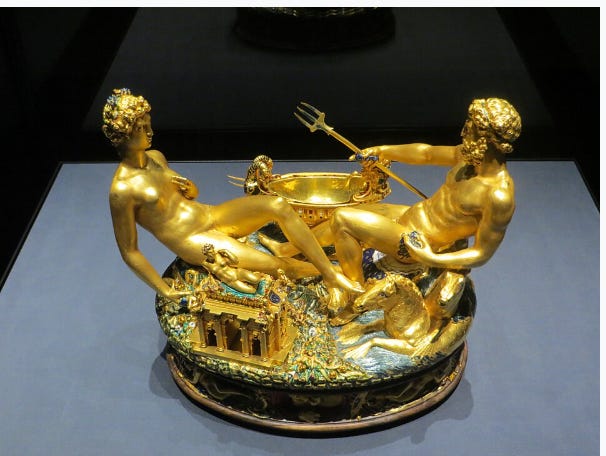AUTHOR’S NOTE: With the lazy days of summer upon us, it occurred to me that our readers might enjoy a break from the heavy and often distressing news of the world, so I have decided to share a true story that I wrote almost twenty years ago. I initially conceived the story as Part I of a two-part book. Part I was to be an account of the theft of Saliera; Part II was to be about the 500-year peregrinations of the “La Peregrina”—the most famous pearl in the world, owned by a long line of prominent ladies, from multiple Queens of Spain to Elizabeth Taylor. I ultimately set the project aside to focus on a big serial killer story, but I still find this tale of a major art heist highly intriguing and entertaining. I have therefore decided to publish it as a multipart series for our paid subscribers.
Because the former Vienna Chief of Police, Ernst Geiger, is a close friend, I was able to access information and documents that were not available to other reporters.
STEALING SALIERA
Stealing Saliera from Room IV of Vienna’s Art History Museum at 3:55 A.M. on Sunday, May 11, 2003 wasn’t difficult, but it was done with great efficiency. What made it easy was the scaffold, erected on west side of the museum for exterior cleaning. Because it was draped with cloth, the thief was able to climb inside of it to the window of Room IV without being seen from the street below. He then broke the lock on the outer window, cut a hole in the blind, and broke the inner window. Because there were no sensors on the windows, he didn’t set off the alarm until he entered the room and tripped a motion detector. He then ran about ten feet to the heavy glass case containing Saliera, smashed it with a blunt instrument, grabbed it, put it in a bag, ran back to the window and vaulted out. According to the chief night watchman, the thief was in the room for less than fifty three seconds.
For someone paying close attention, the weaknesses of Room IV’s security were easy to spot. No bars on the windows and no shock-proof glass surrounding Saliera, and with the covered scaffolding outside, the thief could take all the time he needed to gain access to the room. The risky part began only after he entered and set off the alarm. At the point, he had to allow three or four minutes to grab the goods, scurry back down the scaffold and get out of the construction site at its base.
As it turned out, he could have taken his time making his getaway, because when the alarm went off, the watchman sitting at the security console on the ground floor presumed it was a false alarm (he’d recently been plagued with a number of them). After it sounded for 25 seconds, he shut it off for 29 seconds, and when he turned it back on, it wasn’t activated a second time. All was still in Room IV, and so he decided to do nothing. At 8:20 A.M., over four hours later, a cleaning lady discovered the shattered glass case that had, the day before, contained Saliera.
The investigators who arrived at the scene later that morning wondered how much the thief had been able to ascertain about Room IV’s security in advance. Did he know that none of the three watchmen would be making their rounds near the room at the moment the alarm went off, or did he just make a gamble? Did he know he would have enough time to execute the theft before the watchman on the ground floor could intervene? The museum’s security consisted of a motion detector alarm system, and it was only as effective as the personnel whose job was to respond to it. The biggest question: Did the thief know the watchmen wouldn’t respond?
The next day, Monday, May 12, the theft was front-page news in most Austrian papers, and was widely reported in the international press as well. The Interior Ministry announced a 70,000 Euro reward for anyone with leads to the thief. The Art History Museum director, Wilfried Seipel, stated that the unique object would be practically impossible to sell, which suggested that the thief either loved Saliera or was an extortionist. At a press conference the next day, Seipel announced a different hypothesis: the theft was a professional job commissioned by the Mafia.
Click this link for the original source of this article.
Author: John Leake
This content is courtesy of, and owned and copyrighted by, https://petermcculloughmd.substack.com and its author. This content is made available by use of the public RSS feed offered by the host site and is used for educational purposes only. If you are the author or represent the host site and would like this content removed now and in the future, please contact USSANews.com using the email address in the Contact page found in the website menu.









